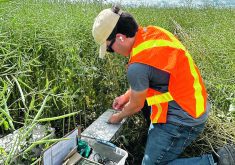VANCOUVER – Canada’s flax industry has incurred substantial costs in the two years since a genetically modified variety was discovered in the handling system.
Sales to Europe are expected to be 100,000 tonnes in 2011-12, only one-quarter of what they were in the pre-Triffid era.
Canada’s share of the EU flax market has fallen to 20 percent from 80 as flax from Eastern Europe replaces Canadian product.
“There’s a new competitor, at least in the short run, for a market that has traditionally been Canadian,” said Flax Council of Canada president Will Hill.
Read Also

Research looks to control flea beetles with RNAi
A Vancouver agri-tech company wants to give canola growers another weapon in the never-ending battle against flea beetles.
“It could lead to where the EU is no longer our preferred market for flax.”
Shipping to Europe has become costly and risky under a rigid trade protocol that allows for a maximum .01 percent Triffid contamination.
“(The protocol) is more than the grain industry is used to. It is a very rigorous process that causes extra storage, extra testing and extra reporting,” he said.
Hill believes the only way to resurrect the EU market is to convince Europeans to adopt a low level presence policy for unapproved GM traits. A 0.1 percent tolerance level would alleviate most of Canada’s concerns.
But before Canada can make any credible demands of importers, it needs to address its own shortcomings.
Agriculture Canada is in the midst of public consultations on a new policy for low level presence (LLP) that it hopes will be an example of how to resolve one of the biggest impediments to agricultural trade.
“This is a real problem. It’s a growing problem. We need to address it. We need to find a practical way of dealing with this on a global basis,” said Blair Coomber, director general of multilateral relations, policy and engagement with Agriculture Canada.
The department is meeting with its 11 value chain roundtables to generate feedback on the proposed policy, which includes a recommendation that would allow imports to contain less than 0.1 percent of a GM crop that was approved in the exporting nation but not yet approved in Canada.
“We believe there is a significant opportunity for Canada to take some leadership on this globally,” said Coomber.
The hope is that once Canada’s policy is implemented, it could be used as a template by other regions such as the EU.
Low level presence has blindsided most major importers and exporters at some point.
Randal Giroux, vice-president of food safety, quality and regulatory affairs with Cargill, said zero tolerance policies for unapproved GM traits have become a major headache for grain shippers.
“We see huge potential risks in exporting,” he said.
“The aggressive commercialization of these traits wreaks havoc with the supply chain. We’re having dialogue and discussions about how do we manage the needs of both the export markets and the domestic market.”
The problem will only get worse because of the increasing number of GM products about to hit the market and the asynchronous approvals of those products around the world.
Trade can be disrupted when trace amounts of a GM product approved in the country of export but not the country of import appears in a shipment of grain.
Even the EU, the bastion of anti-GM crop sentiment, is taking steps to avoid such costly disruptions.
“The European Commission is acutely aware of the impact of low level presence,” said Niall Gerlitz, director general for health and consumer policy with the European Commission.

















